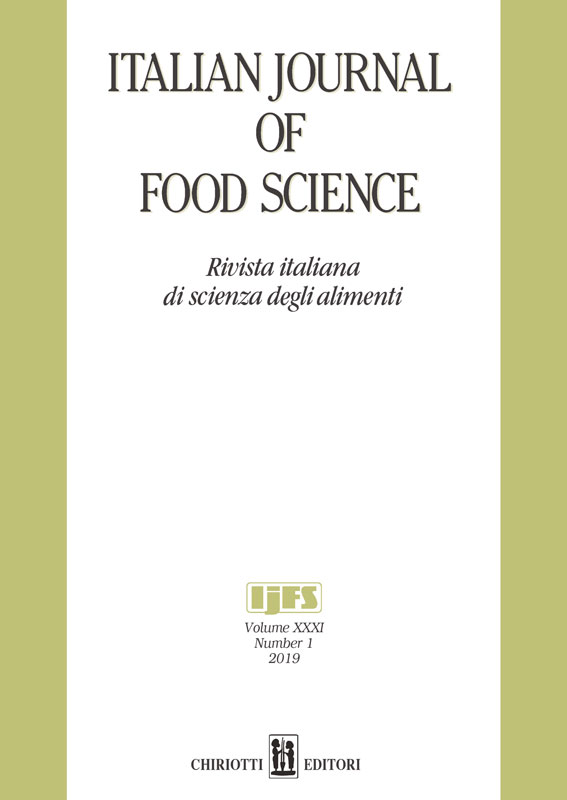DETERMINATION OF SUNSET YELLOW IN DIFFERENT BRANDS OF ORANGE JELLIES OF BANGLADESH BY HPLC
Main Article Content
Keywords
HPLC, orange jellies, sunset yellow-FCF, synthetic food color, BSTI
Abstract
Synthetic colorants may have adverse health effects, therefore, it is necessary to ensure controlled use of these colorants in various alimentary products. In this study, 54 samples of six brands of orange jellies were analyzed for the determination of ‘Sunset Yellow’ color by High Performance Liquid Chromatography. The results showed that the value of Sunset Yellow in one brand of orange jelly exceeded the Bangladesh Standard and Testing Institute (BSTI) value, the values in four other brands were within the range of the BSTI value, and it was absent in the last one. One brand yielded more than twice the maximum BSTI value and four times the maximum value from the European Union. These results indicated that there is a need to monitor the amounts of synthetic colorants used in food products to protect the public health from serious adverse effects related to such chemicals and to create awareness to the consumers as well as policy makers.
References
Alves S.P., Brum, D.M., Branco de Andrade, É.C. and Pereira Netto, A.D. 2008. Determination of synthetic dyes in selected foodstuffs by high performance liquid chromatography with UV-DAD detection. Food Chem.107(1):489.
Bento W.A.S., Lima B.P. and Paim A.P.S. 2015. Simultaneous determination of synthetic colorants in yogurt by HPLC. Food Chem. 183:154.
Bessonov V.V, Malinkin A.D., Perederiaev O.I., Bogachuk M.N., Volkovich S.V. and Medvedev I. 2011. Development of methods for determining acrylamide in food products by gas-liquid chromatography. Vopr Pitan.80(4):79.
Bhattacharjee M. 2014. Evaluation of mitodepressive effect of sunset yellow using Allium sativum assay. Int. J. Sci. Environ. Technol. 3(3):1120.
Das A. and Mukherjee A. 2004. Genotoxicity testing of the food colours amaranth and tartrazine. Int. J. Hum. Genet. 4(4):277.
Elhkim M.O., Héraud F., Bemrah N., Gauchard F., Lorino, T., Lambré C. and Poul J.M. 2007. New considerations regarding the risk assessment on Tartrazine: an update toxicological assessment, intolerance reactions and maximum theoretical daily intake in France. Regul Toxicol. and Pharmacol. 47(3):308.
Ganesan L., Margolles-Clark E., Song Y. and Buchwald P. 2011. The food colorant erythrosine is a promiscuous protein-protein interaction inhibitor. Biochem. Pharmacol. 81(6):810.
Geoffrey B. A. and Felix M. B. 1991. Canthaxanthin and the eye: a critical ocular toxicologic assessment. J. Toxicol. Cutan Ocul. Toxicol. 10(1-2):115.
Hamdy A., Mekkawy A.A., Massoud A. and El-Zawahry M. 2000. Mutagenic effects of the food colour erythrosine in rats. Probl. Forensic Sci. 43:184.
Hinton, D.M. 2000. US FDA“Redbook II” immunotoxicity testing guidelines and research in immunotoxicity evaluations of food chemicals and new food proteins. Toxicol Pathol. 28(3):467.
Joint F.A.O., on Food Additives W.H.O.E.C., Organization W.H. and others 1965. Specifications for the identity and purity of food additives and their toxicological evaluation: food colours and some antimicrobials and antioxidants, eighth report of the Joint FA.
Joint F.A.O., on Food Additives W.H.O.E.C., Organization W.H. and others 1991. Evaluation of certain food additives and contaminants: thirty-seventh report of the Joint FA.
Khera K. S., Munro I.C. and Radomski J.L. 1979. A review of the specifications and toxicity of synthetic food colors permitted in Canada. CRC Crit. Rev. Toxicol. 6(2):81.
Kirschbaum J., Krause C., Pfalzgraf S. and Brückner H. 2003. Development and evaluation of an HPLC-DAD method for determination of synthetic food colorants. Chromatographia 57:S115.
Koutsogeorgopoulou L., Maravelias C., Methenitou G. and Koutselinis A. 1998. Immunological aspects of the common food colorants, amaranth and tartrazine. Vet. Hum. Toxicol. 40(1):1.
Kucharska M. and Grabka J. 2010. A review of chromatographic methods for determination of synthetic food dyes. Talanta 80:1045.
MacDougall D., Crummett W. B. and others 1980. Guidelines for data acquisition and data quality evaluation in environmental chemistry. Anal Chem. 52(14):2242.
Malczyk E., Wyka J., Calyniuk B., Zolotenka-Synowiec M., Misiarz, M. and Gawlowski M. 2015. An Assessment of the Intake of Synthetic Food Colors by 10-15-Year-Old Children. Nurs. Publ. Health 5(4):323.
Mathur N., Chaudhary V., Mehta M. and Gupta S. 2005. Sunset yellow induced changes in the lipid profile in male albino rat. Biochem. Cell. Arch. 5:197.
Meinicke R.M. and Jorge L.N. 2008. Estudo da produção de pigmentos por Monascus ruber CCT 3802 utilizando glicerol como substrato em cultivo submerso. Universidade Federal de Santa Catarina. www.repositorio.ufsc.br/xmlui/handle/123456789/90907
Mpountoukas P., Pantazaki A., Kostareli E., Christodoulou P., Kareli D., Poliliou S. and Lialiaris T. 2010. Cytogenetic evaluation and DNA interaction studies of the food colorants amaranth, erythrosine and tartrazine. Food Chem. Toxicol. 48(10):2934.
Pylypiw H.M. and Grether M.T. 2000. Rapid high-performance liquid chromatography method for the analysis of sodium benzoate and potassium sorbate in foods. J. Chromatogr. A 883(1):299.
Rao P. and Sudershan R.V. 2008. Risk assessment of synthetic food colours: a case study in Hyderabad, India. Int. J. Food Saf. Nutr. Publ. Health 1(1):68.
Sardi M., Haldemann Y., Nordmann H., Bottex B., Safford B., Smith B. and Jasti P.R. 2010. Use of retailer fidelity card schemes in the assessment of food additive intake: Sunset Yellow a case study. Food Addit. Contam. 27(11):1507.
Sun H., Sun N., Li H., Zhang J. and Yang Y. 2013. Development of multiresidue analysis for 21 synthetic colorants in meat by microwave-assisted extraction -solid-phase extraction reversed-phase ultrahigh performance liquid chromatography. Food Anal. Method. 6:1291.
Swaroop V.R., Roy D.D. and Vijayakumar T. 2011. Genotoxicity of synthetic food colorants. J Food Sc Eng.1(2):128.
Tsuda S., Murakami M., Matsusaka N., Kano K., Taniguchi K. and Sasaki Y.F. 2001. DNA damage induced by red food dyes orally administered to pregnant and male mice. Toxicol. Sci. 61(1):92.
Watabe T., Ozawa N., Kobayashi F. and Kurata H. 1980. Reduction of sulphonated water-soluble azo dyes by micro-organisms from human faeces. Food Cosmet Toxicol. 18(4):349.
Yuan Y., Zhao X., Qiao M., Zhu J., Liu S., Yang J. and Hu X. 2016. Determination of sunset yellow in soft drinks based on fluorescence quenching of carbon dots. Spectrochim Acta A Mol Biomol. Spectrosc 167:106.



